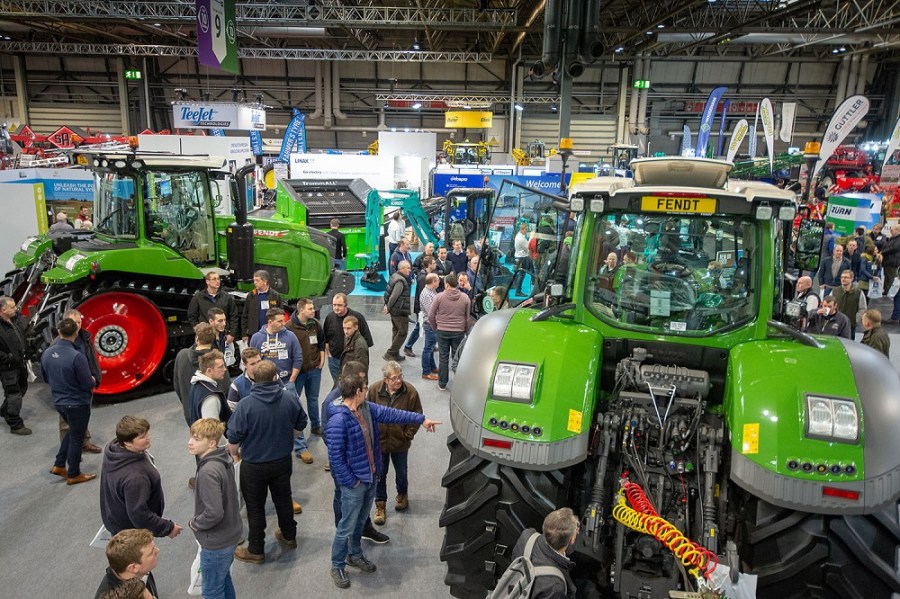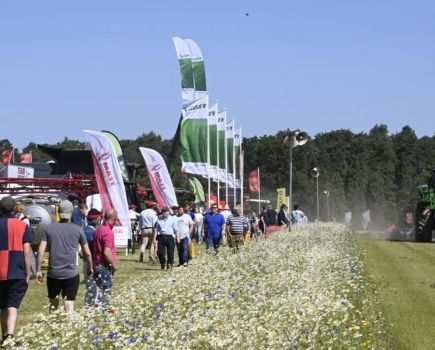Exhibitors and visitors are heralding
LAMMA’s move to the NEC in Birmingham as another step in its passage from strength to strength. CPM was there to gauge the mood and pick out the finds.
There was a real sense of excitement and buzz.
Peter Hill
Well that was a success! Anyone who walked around this year’s LAMMA show in brogues and a light sweater – instead of the heavy boots, thick socks, umpteen upper layers and a woolly hat needed in past years – will have appreciated the change of environment.
And will recognise the positive mood at an event where farmers, contractors and exhibitor staff could talk in detail about machinery developments and potential investments without being distracted by numbing cold.
For once, perhaps, we can agree with the organisers’ hype: “We are thrilled with the incredibly positive feedback, both from our exhibitors and visitors taking part, after we provided the show UK agriculture deserves,” said AgriBriefing group events director Elisabeth Mork-Eidem.
“Around 40,000 people attended the event, and there was a real sense of excitement and buzz throughout the 11 packed NEC halls.”
Having committed a lot of expenditure to present decent displays of equipment, exhibitors with their fingers firmly crossed as the doors opened at 8.30am sharp were rewarded with a sudden influx.
“We had a busy stand right from the word go, visitors were engaged by what we had to show them and I heard no criticisms of any sort about the event,” said Adrian Winnett of McCormick manufacturer Argo Tractors.
“I think LAMMA has been re-established as a more comfortable, more accessible ‘must attend’ show.”
Fendt national sales manager Martin Hamer said: “We have been really, really busy. We firmly believe agriculture deserves a really good shop window and we’re very pleased to be at the NEC – it’s been a really positive experience.”
Beyond the euphoria – and relief – of a well-attended first indoor show, there remained the question of whether companies could justify the significantly higher cost of exhibiting.
“Without a doubt,” was the response of Adrian Tindall of irrigation equipment manufacturer Bauer. “One of my colleagues is hoarse from having so many good quality conversations with people; we’ve been busy throughout, so it’s definitely been worth the investment.”
It was also good to see that the event still attracted many smaller suppliers of implements, workshop tools and equipment, farm clothing and the like, who also were attracting plenty of attention alongside the ‘big boys’.
James Duggleby of Krone UK appeared to sum up everyone’s view: “The LAMMA show’s move to the NEC has been fantastic. We’ve seen what we think is record attendance, a great positive mood, fantastic enquiry levels and everybody seems to have really embraced the move indoors. See you again in 2020!”
Refined designs
Fresh options for cultivations, ploughing and drilling were much in evidence at LAMMA 2019 as growers weighed up the features and potential benefits of new and refined designs – as well as new suppliers exhibiting alongside established manufacturers.
Among the latter, Weaving Machinery continues to make progress in refining the design and style of its seed drills, as evident from the down-sized version of the latest GD trailed drill on show.
This caters for growers wanting 6m working width to suit available tractor power; the drill is also available in 8m and another three widths from 4m in addition to the 3m mounted model.
The GD is designed for zero-tillage crop establishment using disc coulters to place seed but is said to also work well in pre-cultivated situations.
Its core feature is the patented twin disc coulter assembly, which is canted over 25° from the vertical, with the larger of the two discs slicing into the soil and the smaller one opening the resulting angled slot to place seed.
Weaving Machinery says eliminating the sidewall pressure inherent in a vertical twin disc design results in the slot being closed more easily – the lifted ‘flap’ of soil is firmed down by a press wheel that also regulates working depth – results in less risk of smearing and also a lower power requirement.
The GD is significantly more compact than previous Weaving disc drills because the 5000-litre hopper is positioned over rather than ahead of the two rows of coulters, which the operator can now see more easily.
It also has GPS speed monitoring with auto variable rate seeding possible, and ISOBUS electronics to operate with a touch screen terminal in the tractor cab.
Compact Claydon
Claydon’s latest 6m trailed drill is also more compact – and lighter – than predecessors so that it can be operated behind a less powerful tractor or is less power-demanding when working in hilly areas of the country.
The T6c is more than 20% lighter than the full-size model, largely as a result of having a hopper down-sized from 5500-litres to 3500-litres, and is reckoned to be capable of drilling typically 45ha a day behind a 300hp tractor.
The seeding concept is the same – a soil-loosening tine to remove compaction and aerate the soil leads the way, followed by a tine coulter at a slightly shallower depth, which creates additional tilth as it places seed above the drainage channel created by the leading tine.
On the trailed drills, these components are mounted on a ‘floating’ frame supported separately from the main frame in order to isolate the coulter assemblies from the varying weight of the seed hopper’s contents.
The hopper can be used for seed only or with a 60:40 seed:fertiliser split to get selected crops off to a fast start.
It’s primarily aimed at direct drilling into stubble to minimise energy input and costs when establishing grain and oilseed crops, but Claydon says the hardware also works effectively on min-till seedbeds and on ploughed and/or more comprehensively cultivated land.
Precision vision
A fair chunk of the Väderstad stand was taken up by a new 24-row version of the Tempo L precision planter – which the company reckons is the largest high-speed planter for sugar beet and oilseed rape.
‘High-speed’ is the important caveat here because unlike more conventional planters, the Tempo L is one of a new breed capable of planting a range of crops, including maize, at faster speeds than is typical.

The trailed Tempo L high-speed precision planter is reckoned to be the widest of its type at 24 rows.
Väderstad says speeds up to 15km/h are recommended but that very low levels of misses and doubles have been recorded in laboratory trials approaching 17km/h.
Key to this ability is the Tempo’s Gilstring pressurised – as opposed to vacuum – seed metering system and the PowerShoot concept that propels each seed down a narrow tube into the furrow.
In the metering unit, each seed is held in place against a perforation by air pressure until a small wheel on the other side blocks the airflow, whereupon the seed is propelled (rather than left to fall) to the furrow.
There, it is captured beneath a soft press wheel to prevent bouncing and ensure intimate seed-to-soil contact.
Electric drive to the metering system makes it possible to switch off each row individually, with GPS control and a digital map providing automatic control to prevent rows overlapping.
All versions of the trailed Tempo L can have a 5000-litre fertiliser hopper feeding placement discs ahead of the planting units that carry seed hoppers from 100-litres on narrower models to 25-litres capacity on the widest version.
Row spacing is adjustable in each case, on the 24 L in four steps from 450mm to 508mm.
Shallow solution
Low disturbance soil loosening at relatively shallow depths is the purpose of new implements from Grange Machinery and Dale Drills.
Common features include vertical flat discs to slice through the surface, slim legs with modest wings and a packer roller to level off and firm up any resulting surface heave.
Grange Machinery, started on an arable farm in East Yorks by Rhun Jones, is a young business established by manufacturing a tractor-mounted soil loosening toolbar primarily to operate with any other trailed implement – mainly a roller or seed drill.
The latest version is more of a stand-alone implement in that it has a packer-roller attached to pivoting arms extending from the main frame.
Apart from consolidating the resulting tilth, the packer regulates the working depth of the tines, which is adjusted by a pin and hole mechanism on the arms.
There are 3m and 4m sizes, the latter having a main beam and disc toolbar with telescopic sections that are moved in for transport and out for work using a lever crank at each position, and a hydraulically folding rather than rigid packer.
In both cases, the depth of the leading discs relative to the tines and packer is adjustable by a hydraulic cylinder that can also lift them out of work altogether.
Each is attached to the toolbar by a rubber damped clamp.
Turnbuckle adjustment
The discs on the Meir Agriculture implement built by Dale Drills are attached rigidly to tapered box section arms welded to a toolbar that is adjustable by turnbuckles to vary the disc working depth.
Two rows of slim tines in a staggered formation and mounted on a hydraulically-folding three-bar frame perform the soil loosening function, while a turnbuckle-adjusted packer roller completes the set up.
Tom Dale explains that the family wanted something better than they had for taking out wheelings across approximately 23% of the Lincs farm where their implements are built as part of a controlled traffic farming (CTF) regime.
Setting the discs about 25mm deep to “tear along the dotted line” as Tom Dale puts it, together with long points and wings splayed downwards, are designed to enable the tines to do their job at shallow depths without causing excessive surface heave.
What to wear
A new addition to JJ Metcalfe’s NG component system for soil loosening cultivation on a number of different implements is designed to combat wear of the base parts, especially in highly abrasive soils.
The NG Endurance soil-engaging components have strategically located tungsten carbide tiles formed to sit within the existing profile of the point and saddle-shaped shins.
They therefore provide an extra defence against abrasion without changing the profile of the complete assembly or creating extra drag.
For now, the individually replaceable point, narrow, tapered and curved shins are available for Metcalfe’s Option 2 low draft, low surface disturbance assembly, which is designed for 150-350mm working depths.
This is one of the company’s most popular of four options, being a good all-rounder, says Abi Metcalfe, but the NG Endurance components will also be available for the equally popular Option 1 for 100-300mm working depths.




